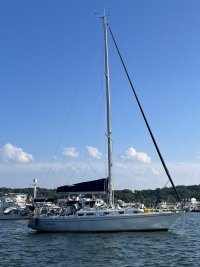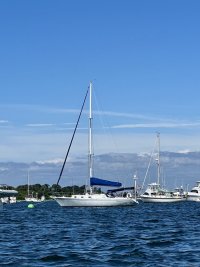bsangs
E35-3 - New Jersey
Once the shrink wrap comes off in mid-to-late March, I'm planning to install a Garmin Fantom 18x dome radar. The plan is to affix it atop my existing transom mounted pole, which is currently topped by a useless domed TV antenna. The pole is roughly six or seven feet higher than my hard top bimini. I also have some other antennae (antennas?) on this pole - AIS, GPS, VHF. The Fantom radar dome will be mounted above these, though not by a significant amount. It'll interface with my Garmin chart plotter. (You can see the pole in the attached photos.)
It's my first foray into radar, so I'm trying to get the actual skinny on this setup.
-- Will there be significant interference among those antennae?
-- And am I making a mistake mounting the radar on the transom pole instead of halfway up the mast? I see plenty of motorboats with radar mounted lower than this will be mounted, so my thinking is it'll work just fine at that height. Am I wrong? (A mast mounting makes this a much more challenging project, but still doable.)
Should mention I'm not interested in detecting bird flocks. This is just for weather, traffic, obstacles, etc. Going to be heading into some foggy waters near Nantucket, Cape Cod and Martha's Vineyard this summer, so bringing a radar into the fold seems like a prudent idea.
Appreciate any and all feedback.


It's my first foray into radar, so I'm trying to get the actual skinny on this setup.
-- Will there be significant interference among those antennae?
-- And am I making a mistake mounting the radar on the transom pole instead of halfway up the mast? I see plenty of motorboats with radar mounted lower than this will be mounted, so my thinking is it'll work just fine at that height. Am I wrong? (A mast mounting makes this a much more challenging project, but still doable.)
Should mention I'm not interested in detecting bird flocks. This is just for weather, traffic, obstacles, etc. Going to be heading into some foggy waters near Nantucket, Cape Cod and Martha's Vineyard this summer, so bringing a radar into the fold seems like a prudent idea.
Appreciate any and all feedback.


